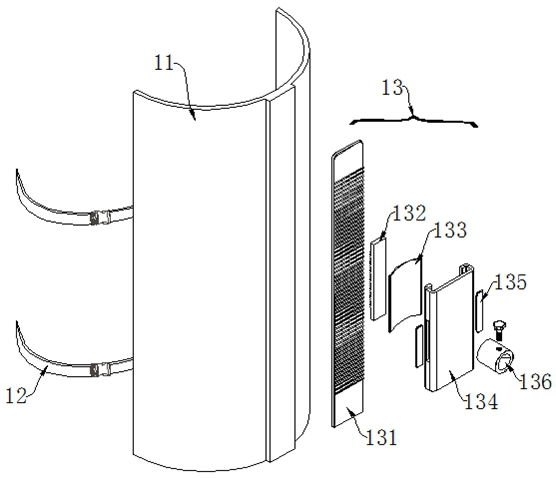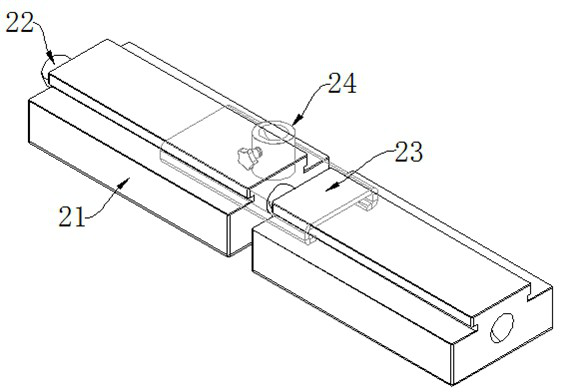Subcutaneous tumor removing device
A limb and support module technology, which is applied in the field of medical and surgical instruments, can solve the problems of tumor location, depth and shape judgment deviation, no support mechanism for auxiliary support, tumor shape shrinkage, etc., to improve the support effect, facilitate recovery, improve The effect on success rate
- Summary
- Abstract
- Description
- Claims
- Application Information
AI Technical Summary
Problems solved by technology
Method used
Image
Examples
Embodiment 1
[0029] like Figure 1-7 As shown, a subcutaneous tumor removal device includes a limb support module 1, a tumor limit module 2, a connection module 3, an arm support module 4 and a telescopic ball head rod 5, and the limb support module 1 is connected to the arm through the connection module 3. The support module 4 is connected, the tumor body limiting module 2 is pasted on the outer surface of the skin of the affected limb along the path outside the tumor body by medical adhesive tape, and the limb supporting module 1 and the arm supporting module 4 are connected to the tumor body limiting module 5 through the telescopic ball head rod 5. bit module 2 connection.
[0030] The limb support module 1 includes a waist support 11, a corset 12 and a first limit mechanism 13. The waist support 11 fits the patient's waist and abdomen through the corset 12, and the lower end of the waist support 11 is connected to the upper end of the hip bone on the side of the affected limb. In case...
Embodiment 2
[0041] like figure 1 , Image 6 and Figure 7 As shown, a subcutaneous tumor removal device includes a limb support module 1, a tumor limit module 2, a connection module 3, an arm support module 4 and a telescopic ball head rod 5, and the limb support module 1 is connected to the arm through the connection module 3. The support module 4 is connected, the tumor body limiting module 2 is pasted on the outer surface of the skin of the affected limb along the path outside the tumor body by medical adhesive tape, and the limb supporting module 1 and the arm supporting module 4 are connected to the tumor body limiting module 5 through the telescopic ball head rod 5. bit module 2 connection.
[0042] The limb support module 1 includes a waist support 11, a corset 12 and a first limit mechanism 13. The waist support 11 fits the patient's waist and abdomen through the corset 12, and the lower end of the waist support 11 is connected to the upper end of the hip bone on the side of the...
Embodiment 3
[0047] like figure 1 , image 3 , Figure 4 and Figure 5 As shown, a subcutaneous tumor removal device includes a limb support module 1, a tumor limit module 2, a connection module 3, an arm support module 4 and a telescopic ball head rod 5, and the limb support module 1 is connected to the arm through the connection module 3. The support module 4 is connected, the tumor body limiting module 2 is pasted on the outer surface of the skin of the affected limb along the path outside the tumor body by medical adhesive tape, and the limb supporting module 1 and the arm supporting module 4 are connected to the tumor body limiting module 5 through the telescopic ball head rod 5. bit module 2 connection.
[0048] The tumor limiting module 2 includes a limb part 21, a connecting head 22, a sliding part 23 and a fixing seat 24. The limb parts 21 are sequentially connected through the connecting head 22 to form a closed circuit, and the sliding part 23 is installed on the adjacent lim...
PUM
 Login to View More
Login to View More Abstract
Description
Claims
Application Information
 Login to View More
Login to View More - R&D
- Intellectual Property
- Life Sciences
- Materials
- Tech Scout
- Unparalleled Data Quality
- Higher Quality Content
- 60% Fewer Hallucinations
Browse by: Latest US Patents, China's latest patents, Technical Efficacy Thesaurus, Application Domain, Technology Topic, Popular Technical Reports.
© 2025 PatSnap. All rights reserved.Legal|Privacy policy|Modern Slavery Act Transparency Statement|Sitemap|About US| Contact US: help@patsnap.com



